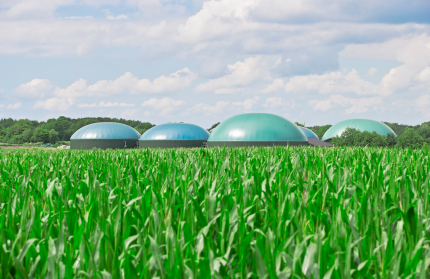|
This issue of the Green Indicator is dedicated to biogas, a renewable fuel that is recieving increasing interest from consumers, industry and policy makers. Biogas production is not only a way of producing sustainable energy and fuels but also a resource efficient method to deal with organic wastes and nutrients. The CatScan describes new developments for catalytic processes using biogas and combining conversion and upgrading.
/Fredric Bauer
Biogas
Biogas is produced from anaerobic digestion of organic raw materials such as sewadge sludge, manure, agricultural waste or energy crops. In the digestion process the organic compounds are converted by methanogenic bacteria to a gas consisting of 50-70% methane and 30-50% carbon dioxide. When using manure that would otherwise have been applied directly to the soils, the methane – an important greenhouse gas – that would otherwise been emitted to the atmosphere is instead utilized. The carbon dioxide can be removed from the gas in an upgrading process which produces a biobased synthetic natural gas (Bio-SNG) with a methane content of about 97%. Several technologies for upgrading the biogas are commercially available; a report reviewing and comparing these technologies was recently published by the Swedish Gas Technology Centre.

This gas can be used in almost any natural gas application, but most commonly today it is used as vehicle fuel in engines fueled by compressed natural gas (CNG). The interest for gas fueled vehicles is increasing, e.g. many city buses are today fueled by biogas and the number of cars running on CNG is also increasing. Today, tractors and other heavy machinery running on biogas are also becoming available.
One problem has been to operate heavy transport vehicles on the fuel as their reach is limited by the lower energy content of CNG compared to diesel fuels. The use of liquefied biogas (LBG) promises a solution to this. Studies have shown that a limited number of strategically placed LBG fueling stations along the main highways can supply a large share of the heavy road transports. It is now possible to meet the strict quality requirements on biogas that is to be liquefied and the first production unit for LBG in Sweden is operating since last year.
Biogas is however not only a sustainable fuel when produced from wastes, the production also yields a rest product which can be used as organic fertilizer, reducing the large need for mineral fertilizer based on fossil resources in the agricultural sector. Further, a cooperative project between countries around the Baltic Sea has shown that macroalgae collected from the beaches can be used to produce biogas, thereby removing nutrients from the sea and thus reducing the eutrophication of the very sensitive Baltic Sea.

More information on the Wetlands Algae Biogas project can be found on http://wabproject.pl/en/.
The report on technologies for biogas upgrading, co-authored by a team from Hulteberg Chemistry & Engineering, is freely available at http://www.sgc.se/ckfinder/userfiles/files/SGC270.pdf.
|



